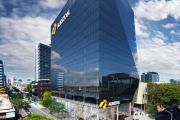
The $40 million makeover to Melbourne's ACMI in Federation Square
In mid-February, as Melburnians emerged from their third lockdown and tentatively started re-peopling their city, they discovered they’d been gifted an excitingly renewed museum that explores screen culture in all its forms.
The Moomba long weekend this month was an excellent gauge of the potential drawing power of ACMI, and it turned out that the Australian Centre for the Moving Image is quite the tourism honey-pot.
According to staff, “huge numbers” poured through the doors of the Federation Square-based facility to experience what a $40 million, five-year makeover had effected on one of the world’s most important screen culture collections.
ACMI has been a component of the Federation Square arts and public gathering ground since 2002.
Yet possibly because it was housed inside what had originally been designed as a four-level retail space with two ambivalent entry points, it never quite got the attention it warranted.
“It was not designed for purpose, and that was the challenge,” according to Tim Black, director of the architectural outfit who led the makeover of what ACMI’s CEO Katrina Sedgwick has called a “visually stunning” result.
To open outwardly with more of a structural welcome to its public, BKK Architects’ main remodelling move was to set beneath the high glass atrium, a wide cascade of honeyed timbers as “a living stair” that runs through the heart of the building to connect all the galleries, cinemas, cafe and shops that sit to the sides of the three public levels.
Giving what had always been missing, which Black explains as “a clear line of sight from city to river, and pockets of different places to dwell, the Living Stair stitches together all the different functions that happen in ACMI”.
A more subliminal social engineering ambition of the redesign was to make the whole place more convivial to being co-inhabited by the different age groups who in the past had patronised ACMI as if they were visiting different addresses.
“It was always a rich and varied institution,” Mr Black said. “But one that had been catering to different demographics. Older cinema-goers went to see movies while younger people went down to the gaming areas. I’ve got children, and we went there again and again”.
If the visitors moving through the galleries this week were any indication, better “cross-pollination of this slipped demographics” is achieved. So is the incorporation of numerous places, such as the stair, lounge area, incidental seating and foyer spaces where visitors can hang out without any sense of being harried.
Mr Black defines the idea of the inbuilt “dwell” points as fulfilling something that public access spaces should always be designed to offer.
“It’s the third aspect of public places. Those places where you want to stop and dwell. Places where you can be alone together.
“This is also the core of moving image culture,” he said. “Cinemas are places where we come together to have individual experiences within a shared setting.”
Structurally, the renewed and rebranded ACMI is the stage for its incredible exhibitions, the biggest of which is The Story of the Moving Image. It looks at the artifacts and products of “the world’s most powerful creative expression”, from its stuttering start in the late 1880s to the latest developments in the media.
Designed by international marketing and media experts Razorfish, it showcases so much of the material that Mr Black says “was always there, but was hidden away”. This quite fantastic add-on to central Melbourne’s main arts hub deserves to be visited again and again, made more possible because entry is free. “It’s a very potent curation.”
With folks propped with their laptops and mobile phones and obviously hanging out to meet friends in such a convivial place, Mr Black believes the new ACMI fulfils what was always the ethos of Federation Square, which is “the democratization of a great public space”.










